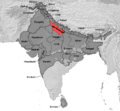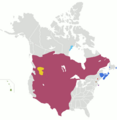Lingua franca facts for kids
A lingua franca is a language that people use to talk to each other when they don't share the same native language. Think of it as a "bridge language" that helps different groups communicate. It's also called a working language or vehicular language.
Contents
What's in a Name? The Story of "Lingua Franca"
The term "lingua franca" first came from Italian. It means "Frankish language."
Hundreds of years ago, around the time of the Renaissance, people in the eastern Mediterranean Sea region used a special mixed language. It was mostly Italian (about 80%), but it also had words from Turkish, French, Spanish, Greek, and Arabic. This language was used for trade and talking between different countries. People called it "lingua franca."
At that time, many Italian speakers lived in the port cities of the Ottoman Empire. The word Franca meant "Frankish" in Italian. Its use in "lingua franca" came from Arabic. Before the Crusades, Europeans were often called "Franks" or Faranji in Arabic. The term "lingua franca" was first written down in English in 1678.
Where Are Lingua Francas Used?
Many languages around the world act as lingua francas. Here are some examples:
- In Africa: Afrikaans, Berber, Fanagalo, Fula, Hausa, Krio, Manding, Sango, Swahili, Wolof
- In Asia: Akkadian, Arabic, Aramaic, Azeri, Bengali, Chinese, Hebrew, Hindi-Urdu, Malay-Indonesian, Nepali, Persian, Sanskrit
- In Europe: English, French, German, Greek, Italian, Latin, Polish, Portuguese, Russian, Serbo-Croatian, Spanish, Yiddish
- In Pre-Columbian America: Chinook Jargon, Nahuatl, Quechua, Tupi
- Pidgins and Creoles: Guinea-Bissau Creole, Tok Pisin
- Across all continents: Esperanto (as an auxiliary lingua franca)
English: The Global Bridge Language
Today, English is the main lingua franca for international business, science, technology, and flying. It took over from French as the language of diplomacy after World War II.
English started becoming important in diplomacy in 1919, after World War I. The Treaty of Versailles was written in both English and French. English became even more important because of the big international roles of English-speaking countries like the United States and the Commonwealth of Nations after World War II. This was especially true when the United Nations was created. English is one of the six official languages of the United Nations. The others are French, Arabic, Chinese, Russian, and Spanish.
When the United Kingdom had many colonies, English was the lingua franca in those areas. After these colonies became independent, some new nations had many different local languages. They decided to keep using English as a lingua franca. This helped avoid problems that might have come up if they had chosen just one local language.
French: A Language of Diplomacy and Art
French was the language of diplomacy in Europe starting from the 13th century. Because of this, it is still a working language for many international groups. You can see French on documents like passports and airmail letters.
For many years, French and German were the only official working languages of the European Economic Community. This was true until the United Kingdom, Ireland, and Denmark joined in 1973. French was also the lingua franca for European literature in the 18th century.
German: A Central European Connection
German was a lingua franca in large parts of Europe for hundreds of years. This was mainly true in the area of the Holy Roman Empire.
German was one of the official languages of the Austro-Hungarian Empire. Because of this, it stayed an important second language in much of Central and Eastern Europe long after World War I. Even today, it is still the most common second language in some countries in that region. For example, 45% of people in Slovenia speak it, 34% in Croatia, 31% in the Czech Republic, and 28% in Slovakia. Many people also know German in Poland (18%) and Hungary (16%).
Greek and Latin: Ancient World Languages
During the time of the Roman Empire, Greek and Latin were the main lingua francas.
In the Middle Ages, Greek was used as a lingua franca in parts of Europe, the Middle East, and North Africa where the Byzantine Empire was powerful. Latin was used in the rest of Europe. Latin was also the common language of the Roman Catholic Church.
During the Second Vatican Council, Catholic church services started using local languages. However, Latin is still the official language of the Vatican. Latin was also used as the language for scholars in Europe until the early 19th century for most subjects.
Images for kids
See also
 In Spanish: Lengua franca para niños
In Spanish: Lengua franca para niños





